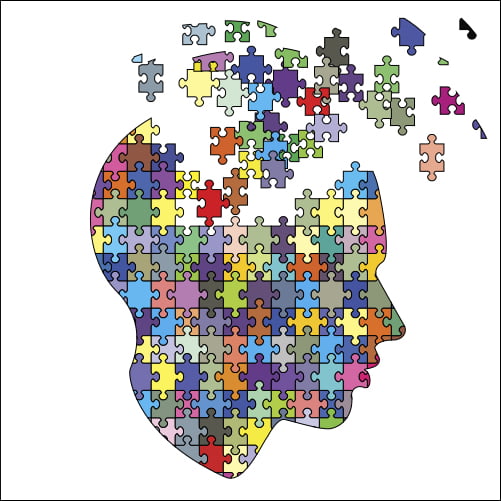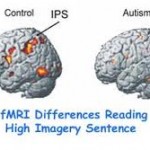The various types of autistic behaviors that I see in my medical practice are sometimes bizarre (self-mutilation), sometimes informative (below-the-tummy-rubbing indicating G-I disturbances), sometimes annoying (dropping on the floor and screaming is particularly so), and always interesting to observe. Occasionally, however, a patient presents with such an unusual combination of behaviors that it defines that individual as a category unto itself.
Temple Grandin wrote about her abilities in Thinking in Pictures. She described how language took a back seat to the images that she processed in her unique brain, and wrote that many ASD patients have similar abilities and brain structures.
Just to keep me on my toes, I met a 4 year-old patient this week who thinks in word patterns. Actually, he doesn’t seem to think in the neuro-typical sense, yet he appears to be connected to some of his surroundings. However, he processes the world in a completely unusual fashion. He makes fair eye contact with strangers and seems to communicate well with his mother. He is very well behaved and answers to his name. He “reads” everything – books, posters, signs, anything with words on it. If there is a picture of a dolphin and the word “dolphin”, Jonathan points to the word and says it correctly. The picture is totally ignored. And, it doesn’t seem that Jonathan has any idea that the word and picture are related. Or what a dolphin is. This remarkable young man can read just about any word, and he can sound out those that he doesn’t recognize right away.
Echolalia is one thing. Practice with language. Scripting is another step in that direction. Complex repetition without any sign that there is comprehension is another level altogether.
One of my first ASD patients was an aggressive 11 year-old who could recite a half-hour TV show in, like, 15 seconds (his mother pointed out to me what he was doing). But, it took dozens of viewings to get that information. Jonathan can memorize the dialog of a video the first time, according to his Mom. From what I’ve observed so far, that’s pretty accurate.
Patterns are what seems to make the most sense to Jonathan. He can assemble a complex puzzle (>100 pieces, 6+ years) by himself, and he completes it in his own special way. Most of us would do the outside pieces first, then work toward the middle. This interesting child does “clumps” – putting patterns together until they make up the whole. But it’s the smaller patterns that he seems to appreciate, not the “big picture”.
Were it not for his wonderful Mom and family who have provided conventional interventions, I believe that Jonathan would have appeared similar to the “typical” autistic patient who I first saw in 1975 at Jefferson Hospital. That was a five year-old male, jumping up and down in a painted wooden crib, flapping away and totally unaware of his surroundings or the 20-or-so medical students who were observing him in his hospital room. At the time, the reported incidence was said to be “one-in-five-to-ten-thousand” children (which only meant that it was really rare since there were no Internet registries and few support groups). Those were the days when doctors told parents to put such patients into an institution with the other “retarded” children.
This child has several medical conditions, including G-I symptoms and allergies, which require attention. As we begin to get Jonathan on a more healthy path, I can’t help but wonder what will happen to some of his special qualities. There is a profound block somewhere in his processing that is, rightly so, his mother’s chief concern. I am fortunate that the family has sought my advice and allowed me to be part of their journey.
So little time, so much to learn. Stay tuned.






Those people designed for greatness will be tested and have to overcome road blocks unlike people who are destined for mediocrity will have it effortless
Fantastic blog post. Keep writing.
Thankyou for this marvelous post, I am glad I noticed this website on yahoo.
I like this site so much, saved to fav.
Thank you for taking your time with my son last week. I have a feeling we will have wonderful results with you helping us on our journey
Dang i thought your blog was killer, gave me a car load of information, i never knew, thanks blogger.
Thanks, do you have any email list to sign up to for some more news?
I’m theautsimdoctor on Twitter… I’m not even sure if this answers the question.
hooray; your writings on theater and writing much missed!
So like i saw your blog and it like totally told me whats up thanks for your input. One love.
I have a 6 year old child with an autism spectrum disorder. While he does not throw himself on the floor or self mutilate…I find it very unprofessional for you to coin such behaviors as “bizarre” and “annoying.” Perhaps your patients and their parents would not appreciate such references.
You are entitled to your opinion… don’t take it so personally (my patients don’t). Regards
Nod?-Nod?-Nod?- Siiiiigh.
Wow, that was a very nice post. In fact, someone who actually thinks and understands what they are talking about. I bookmarked the webblog and will keep return here if this is how you always post. Thanks, keep up good work.
Thanks so much for thiscomment! I have not been this thrilled by a text for a long period of time! You have got it, whatever that means in blogging. Anyway, Youre certainly someone that has something to say that people should hear. Keep up the great work. Keep on inspiring the people!
thanks for ones information your information may be very helpful for that Search engine optimisation peoples. along with your information anybody can get the great ranking thanks on your information.
i love it
An applause to you and your site! This is exactly the kind of inspiration people want. This is what gets people going.
My girlfriend and I genuinely liked learning about on this site, I was just eager to know if you trade featured posts? I am always seeking to find individuals to make trades with but it’s merely an opinion I would inquire.
Umm… you can use what you want, I would like a link if possible.
I happen to be commenting to let you be aware of of the superb encounter my cousin’s child experienced viewing yuor web blog. She even learned numerous things, which included what it’s like to possess an ideal helping nature to make the rest really easily comprehend specified complicated matters. You truly surpassed our expectations. Thanks for delivering these helpful, safe, informative and also easy tips on your topic to Emily.
your good
I’ve bookmarked, Dugg, and I joined the RSS subscription. Thanks! .
Terrific, this information is exactly what I was searching for.
Heya, this is one cool article! Thanx for posting this. I was looking for a website which has this kind of info. I the same as greatly farmville! Lucky I found that one! I’ll be visiting here again for sure! lmao
This is such a great resource that you are providing and you give it away for free. I love seeing websites that understand the value of providing a quality resource for free. It?s the old what goes around comes around routine.
Just desired to say th is blog site is in my most effective blog l ist on #46.
Jamorama i think you have a great site here… today was my first time coming here.. i just happened to find it doing a google search. anyway, great post.. i’ll be bookmarking this page for sure.
Thanx for the effort, keep up the good work Great work, I am going to start a small Blog Engine course work using your site I hope you enjoy blogging with the popular BlogEngine.net.Thethoughts you express are really awesome. Hope you will right some more posts.
Oh, I’ve got lots of ideas. Thanks
This idea is such a so great. I totally think that you would all make such sweet blog posts and offer them freely to viewers as you have! Amazing
hi!i just wanted to stop by and say hello all! now back to my gun auction
Pretty insightfull post. Never thought that it was this easy after all. I have spent a a lot of my time searching for someone to clarify this matter clearly and you’re the only one that ever did that. Thanks for everything!
Incredibly usually ws sign I go to find out this net web site. It quite greatly will be pleasant to me. Thanks the author
Nice blog here! Also your website loads up fast! What host are you using? I wish my website loaded up as fast as yours lol
when i was searching yahoo just for this issue, I feel that its no answer for me , but thanks god , your article save me from this,2
whats up awesome website and theme. I am hoping I am not annoying you I merely sought to inquire exactly what wordpress plugin you utilize to display the newest responses on your blog? I would like to do something like that for my website however I cant acquire the plugin or widget for it. Thanks for your time 🙂
I really don’t know… a blogmeister set me up and I only have to fill in the blanks, so to speak. Stalin Babu is his name.
My husband and i were sent here mainly because this particular blog page has been tweeted by a lady I had been following and feel delighted I made it here.
I really like following your blog as the articles are so simple to read and follow. Excellent. Please keep up the good work. Thanks.
Great post, thanks for sharing. Keep up the fantastic work and keep em coming!
Transition between seasons can shake your kids’ health a bit and make them more prone to seasonal allergies.
Great post.
Simply bookmarked your web-site, with thanks for discussing!